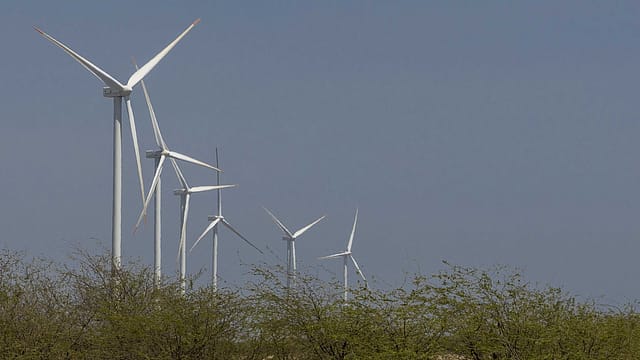India is fast emerging as a global hub for wind turbine manufacturing; here's how
ADVERTISEMENT

With favourable policy support from the government to boost domestic manufacturing, like the recent Revised List of Models and Manufacturers (RLMM), India is emerging as a major manufacturing hub for wind energy. The country, having the fourth-largest installed capacity of wind turbines, has reached a total wind energy installed capacity of 51.6 gigawatt (GW) and has created a manufacturing ecosystem of over 18GW of onshore wind energy equipment.
''India is manufacturing wind turbines ranging from 225 kW to 5.2 MW, with 33 models being produced by 14 companies. These turbines meet our domestic needs and are also cost-competitive globally,'' Pralhad Joshi, Union Minister of New and Renewable Energy, said on June 15, the 'Global Wind Day.''
According to the Ministry of New and Renewable Energy, around 70-80% indigenisation has been achieved with strong domestic manufacturing in the wind sector. All the major global players in this field have their presence in the country with around 14 different companies, through (i) joint ventures under licensed production (ii) subsidiaries of foreign companies, and (iii) Indian companies with their own technology. The unit size of machines has gone up to 5.2 MW and the current annual production capacity of domestic wind turbines is about 18000 MW or 18 GW.
Major domestic manufacturers include Pune-based Suzlon Energy Limited , Inox Wind , TPG-owned Siemens Gamesa , Envision Group, GE Renewable Energy India, Wind World India ( formerly Enercon India), Vestas, Regen Power Tech, Adani Green Energy and Tata Power .
Policy push
India’s Ministry of New and Renewable Energy (MNRE) recently proposed revisions to the List of Models and Manufacturers (RLMM) for the wind energy industry, to boost domestic manufacturing with more clarity on manufacturing in India. The new mandate includes disclosing the names of domestic vendors and the sources of key components, including the blade, tower, gearbox and generator, besides the earlier mandate on turbine model, tower height, rated power, technical collaborations, type certificates, and ISO certifications. Exemption is given for the import of these components up to 200 MW or for one year for any new turbine manufacturer or new model added to the RLMM list. The draft also mandates the storage and maintenance of all data about wind turbines within the country.
December 2025
The annual Fortune 500 India list, the definitive compendium of corporate performance, is out. This year, the cumulative revenue of the Fortune 500 India companies has breached $2 trillion for the first time. Plus, find out which are the Best B-schools in India.
Big demand coming up
India’s annual capacity addition of wind power will more than double to 7.1 gigawatt (GW) on average in the next two fiscal, compared with 3.4 GW in fiscal 2023-25, driven by government measures to ramp up the pace, taking the installed wind capacity up to 63 GW by fiscal 2027, says a Crisil Ratings estimate. The capacity additions over fiscals 2023-25 continued to remain tepid in the range of 6-7 GW on account of fewer successful auctions of wind capacities (5.9 GW in FY21-23 and 5.2 GW in FY23-25). These were largely due to lower interest from developers on account of low tariffs that dampened returns for developers, along with issues in terms of availability of land and transmission infrastructure at sites with high wind potential, says Crisil.
The government’s push towards the auctions of hybrid renewable projects (combining solar, wind and/or storage), as well as an emerging favourable cost regime for wind projects, are expected to drive capacity additions. Hybrid projects offer firm and dispatchable renewable energy (FDRE) and peak power, offering power during peak hours, which was an issue with standalone wind and solar projects. Around 30–50% of the capacities of such hybrid projects are expected to be wind power, as these generate electricity during peak load times.
“We have over 30 GW of hybrid projects in the pipeline, which are expected to be commissioned within the next 2-4 years and would contribute to the expected step-up in wind capacity additions,'' says Ankit Hakhu, Director, Crisil Ratings Limited, in its report in February.
Other favourable factors for wind are the cooling of prices of raw materials such as steel and cement, which form over two-thirds of the project cost, which were high in fiscals 2022 and 2023. Tariffs have also moved to over Rs 3 per unit, viable for project developers. However, the slow pace in land acquisitions and transmission infrastructure is still an issue.
